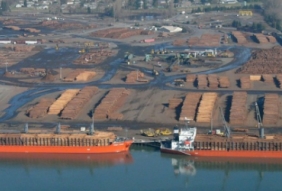
Posted on February 2, 2016
Seaports are seeing a steady rise in waterborne cargo volumes according to a newly released U.S. Army Corps of Engineers’ report. Overall, 2014 freight tonnages increased 3.1 percent over 2013 totals.
The Corps of Engineers’ Waterborne Commerce Statistics Center tracks the commercial movement of U.S. foreign and domestic cargo and vessels. All told, freight volumes moving through U.S. seaports in 2014 reached a three-year high of 2.35 billion short tons. That figure includes both foreign (i.e., import/export) and domestic cargo shipped through and within the U.S. coastal, Great Lakes, non-contiguous and inland waterway ports.
Exports set a record for the fifth year in a row with a year-on-year increase of 3.7 percent to 647.8 million tons. Imports rose for the first time since 2010, up 0.3 percent to 760.9 million tons. Domestic cargo ended the year on a positive note, with coastwise, Great Lakes and inland waterway commerce posting gains from 2013 of 4.3 percent, 3.0 percent, and 5.8 percent, respectively.
The top five U.S. ports ranked by dollar value of foreign traffic for calendar year 2014 were: Los Angeles; New York and New Jersey; Long Beach; Houston; and Savannah.
In 2014, 13.2 percent of all U.S. waterborne commerce by weight was containerized (2.4 percent of domestic and 20.5 percent of foreign).
The U.S. port exporting the largest volume of coal in 2014 was the Consolidated Port of Hampton Roads with 40.6 million short tons, down 15.7 percent from 2013.
The St. Lawrence Seaway Management Corporation reported 30.1 million metric tons (33.1 million short tons) moving on the Montreal-Lake Ontario section of the St. Lawrence Seaway for calendar year 2014, a 5.1 percent increase from 2013.
The Port of South Louisiana was up 12.1 percent in 2014, registering the leading total among U.S. ports with 267.4 million tons.
Tonnage on the Gulf Intracoastal Waterway (GIWW) was 126.1 million tons in 2014, up from 115.4 million tons in 2013.
The number of deep draft dry cargo barges has increased from 448 in 2013 to 461 in 2014, a 2.9 percent increase. The number of double hull tank barges has increased from 3,528 in 2013 to 3,772 in 2014, a 6.9 percent increase.
Based on the Corps’ new report, the American Association of Port Authorities (AAPA) said that while volume of goods moving through U.S. ports in 2014 boosted the nation’s economy, it placed added burden on America’s aging and deficient freight transportation network.
“These figures tell us that America’s farm goods, raw materials and manufactured products continued to compete globally in 2014, while manufacturing and industrial interests, farmers and retail consumers here in the U.S. rekindled demand for imports,” said Kurt Nagle, American Association of Port Authorities (AAPA) President and CEO.
“While this is positive news for the American economy, the increased demand for goods places added strain on our already-overburdened freight transportation system, much of which is used to move cargo to and from our ports. In a 2015 AAPA survey, we found that one in three United States ports estimate they will require at least $100 million in landside connection upgrades to handle their projected 2025 freight volumes.”
Long term, according to AAPA’s analysis of the Corps’ data, the growth trend for U.S. cargo remained positive for foreign trade thanks to the export sector and marginal for the domestic trades.
The data in the Corps’ report features tonnage amounts for all types of waterborne cargo, including dry and liquid bulk, break-bulk, automobiles and containers. Similar data focusing on just containerized cargoes is available at AAPA’s Port Industry Statistics web page.





